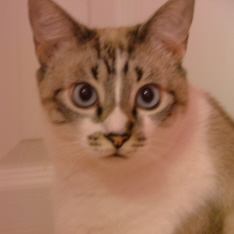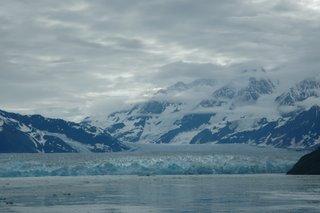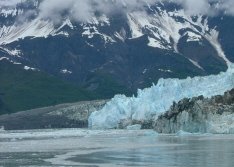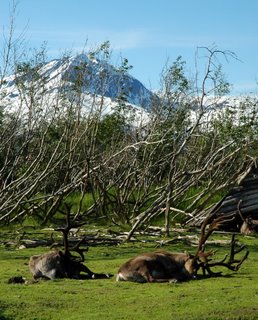Monday, August 28, 2006
“It is difficult to get a man to understand something when his salary depends upon him not understanding it.” Upton Sinclair
The Saturday after returning from Alaska, I went to see the movie, “An Inconvenient Truth”, as I had promised Kathie. Essentially, the movie consists of snippets from Al Gore’s lectures about global warming with some scenes from his life and personal anecdotes thrown in here and there. I won’t critique the movie or Gore’s motivation, but I think he presents the information in an understandable format, and it’s downright alarming. The following quotes from the related website provide the gist of it.
The situation: “The vast majority of scientists agree that global warming is real, it’s already happening and that it is the result of our activities and not a natural occurrence. The evidence is overwhelming and undeniable. We have just ten years to avert a major catastrophe that could send our entire planet into a tail-spin of epic destruction involving extreme weather, floods, droughts, epidemics and killer heat waves beyond anything we have ever experienced. ”
The cause: “Carbon dioxide and other gases warm the surface of the planet naturally by trapping solar heat in the atmosphere. This is a good thing because it keeps our planet habitable. However, by burning fossil fuels such as coal, gas and oil and clearing forests we have dramatically increased the amount of carbon dioxide in the earth’s atmosphere and temperatures are rising."
The effects:
“The number of Category 4 and 5 hurricanes has almost doubled in the last 30 years.
Malaria has spread to higher altitudes in places like the Colombian Andes, 7,000 feet above sea level.
The flow of ice from glaciers in Greenland has more than doubled over the past decade.
At least 279 species of plants and animals are already responding to global warming, moving closer to the poles.
The Arctic Ocean could be ice free in summer by 2050.
More than a million species worldwide could be driven to extinction by 2050.”
The website includes six pages of things that we as individuals can do to lessen our contribution to global warming, and two pages of ways to take action. I’ve started on my list. It’s not going to be easy.
Sunday, August 27, 2006
And Another Expert Weighs In
“Glacier and polar ice store more water than all the world’s lakes, rivers, and the atmosphere combined, and if the world’s ice caps melted completely, sea levels would rise enough to flood much of the Earth and more than half of the world’s cities.”
“Our children, grandchildren, and many more generations will bear the consequences of choices that we make in the next few years.”
And It’s Not Just Greenland’s Glaciers…
- Quelccaya Glacier, the largest in the Andes Mountains, provides water to Cuzco, Peru (which Kathie and I visited in 2000 when we hiked the Inca Trail). The Quelccaya glacier has shrunk by thirty percent since 1974. As a result, farming in the area is threatened and water is already being rationed to Cuzco’s residents.
- Other glaciers throughout the Andes are shrinking as well, putting the water supply for Lima (eight million residents) and Bolivia at risk.
- The glaciers of the Himalayan Mountains provide water to India and Nepal. “Drastic” water shortages are looming for people living in those countries and China.
- Experts estimate that the snows on Mount Kilimanjaro will be gone altogether in fourteen years.
Most Wanted
Color: Brown/grey tabby
Gender: None
Weight: A svelte 10 pounds
Color: White/Siamese mix
Gender: None
Weight: A whopping 19 pounds
I Don't Cook
Inertia II
Maybe I'd better start thinking about moving to higher ground.
Scary stuff. So yeah, now I’m into glaciers and global warming big time. Kathie would probably say I’m obsessed with it. My next few posts will probably be about glaciers and global warming. Hopefully, she will interject some more personal (and interesting?) posts along the way. :-)
Saturday, August 26, 2006
Inertia
In the meantime, I seem to have lost my blogging inertia. Oh, I’ve been reading other people’s blogs a lot, especially some written by a group of friends in England. (I especially enjoy this one.) I feel a bit like a voyeur reading these guys’ posts about their lives and their opinions about what’s going on around them, but fortunately they haven’t told me to butt out – yet. I find that they write well and with astuteness, and the comments they write back and forth, teasing and supporting each other, are genuine and clever. And I guess I’m just starved for intelligence from beyond Charleston...
I have to get back to my own writing, however. Sometimes, just making a simple decision reboots my motivation. So today I decided to drop the “My Friends and Family” blog. It was a nice idea, but for the most part my friends and family are just not interested in blogging. I did want to preserve the following post, though, written by my sweet and brilliant daughter, Jessie.
On July 11th, she wrote:
The Job.
I work in the NNICU: Neonatal Intensive Care Unit. I've only been here for 2 years. I was hired straight out of nursing school. So this is all I know. And I'm slowly starting to wonder what am I doing? Why am I participating in prolonging agony for my babies and their families?!?! What does God have planned for me? I became very close to two families in particular. And each case ended in a funeral. Our dark outcomes outweigh our miracles. We have NNICU reunions to celebrate these miracle babies. But what about the ones that don't make it...or rather we save and then they don't make it. They were never supposed to be here in the first place. My job has become just that - a job. I don't want to save them...I want them to go home to the angels.
No sooner had I tidied up my eye makeup after reading Jessie’s post than the following comment from Kathie appeared:
Hanging on my wall for the last twenty years is a photograph of a pigtailed girl wearing her AK's oversized white tee shirt. She is sitting on the ground of my garden, watering a young tomato plant with a watering can almost as big as she. The expression on her face is total concentration and devotion to that plant.
Well, that plant's days were numbered but the care it received that day made its life more bearable and it knew it was being taken care of by someone with a lot of love and devotion.
I am so proud that little girl has grown up into a fine young woman who gives her love, devotion and energy to these babies. Some will make it, some won't, and some will have challenges in life, but all will have had the honor to receive care from an extraordinary person.
Sorry, I’ve got to go now and find another box of tissues.
Sunday, August 13, 2006
And Finally, An Inconvenient Truth

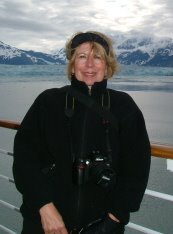 When we get together, whether in person or on the phone, Kathie brings me up to speed on current events as she understands them. This is always a good thing because I don’t read newspapers; therefore the only “news” I get is from the Charleston TV stations and the Today Show. This visit, when she wasn’t gushing over her latest boyfriend, Anderson Cooper on CNN, Kathie was filling me in on Al Gore’s movie, “An Inconvenient Truth”. On Friday morning we got an up close and personal view of the Hubbard Glacier, and at last I understood what she’d been going on about.
When we get together, whether in person or on the phone, Kathie brings me up to speed on current events as she understands them. This is always a good thing because I don’t read newspapers; therefore the only “news” I get is from the Charleston TV stations and the Today Show. This visit, when she wasn’t gushing over her latest boyfriend, Anderson Cooper on CNN, Kathie was filling me in on Al Gore’s movie, “An Inconvenient Truth”. On Friday morning we got an up close and personal view of the Hubbard Glacier, and at last I understood what she’d been going on about.At the entrance to Yukatat Bay, we picked up a pilot as well as a Tlingit storyteller, the storyteller’s daughter, and his niece. As the ship cruised into the bay, the locals provided details and anecdotes over the speaker system about the area. At least, I think they did. Being partially deaf, I couldn’t tell you what they talked about. Besides, I was too busy being overwhelmed by the magnitude (six miles wide with a face that rises the length of a football field above the water) and cold blue beauty of the approaching glacier…and jostling with the other passengers for a good photo-snapping spot.
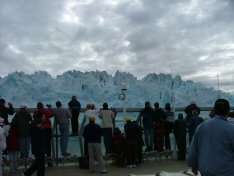
And snap photos we did. Every time we heard what sounded like thunder, real quick we whipped around to catch a shot of the ice calving off the cliff and tumbling into the water below. The crowd oohed and ahhed. Click, click, click went all the cameras. This was an amazing sight that everyone should see. Or should we? Was this much calving normal? Or was it, as we suspected, the result of global warming? I promised Kathie I would see Gore’s movie when I got back to Charleston.
We lounged around the rest of the day and I updated one of Kathie’s necklaces. Seeing the new version on her, you would never guess that necklace was thirty years old! After pasta bar for dinner (what can I say? I love pasta!), we enjoyed the clear sunny night while we walked seventeen laps around the top deck. The goal was twenty, but I whined so much that Kathie had to give in to save her hearing.
Next morning, we sadly said good-bye to our cabin and crew, disembarked in Seward, and boarded a coach for Anchorage. Our driver chatted and pointed out wildlife along the highway through the Kenai Peninsula. At the Alaska Conservation Center, we saw bison, mooses (meese?),
porcupines, and bears. Rescued along a roadside, baby moose Honeymoon was only a few weeks old and looked very sweet as she lay curled up against the fence, sleeping contentedly. Across the drive, however, the caribou (we know them here as Santa’s sleigh pullers) were having a little difficulty sleeping on their curlers.
As we pulled into Anchorage where we would board a flight back to Vancouver, we could see Denali in the distance. I think that’s one mountain Kathie won’t be climbing.
After spending the night in Vancouver, Kathie and I bid each other a tearful adieu the next morning and went off our separate ways into the wild blue yonder…back to reality where we would cross off yet another dreamy destination from our “to do” list. Thanks for a g-r-e-a-t time, Kath!
More tears are shed over answered prayers than unanswered ones....*
“How did this happen?” I asked.
“I don’t have any friends there.”
Anna is 81 years old now, with a frail body about the same number of pounds as her age, housing a still-sharp brain. Her body, though, has not aged well. She manages to deny the involuntary clacking of her implanted teeth and slow shuffle brought on by Parkinsonism, and talks of the walks she takes to the park near her facility.
“I’ve hiked all over the world,” she proudly told me a year ago when she came as a new patient. She listed the places she and her companion, Paul, had gone in recent years, mostly in the southwestern United States.
Anna grew up an only child in Estonia, a small northern European country bordering Russia, Latvia, and the Baltic Sea. She was orphaned at age 14 when her parents were murdered by the Russians -- mentally I calculated this was about 1938 and made a note to check the Estonian politics of this era. She finished medical school in Germany and immigrated to Canada for training in anesthesiology, practicing for most of her career in Detroit.
I wanted to ask other questions. Were her parents political dissidents? How was she able to go to medical school after being orphaned? What was her life during World War II in northern Europe? Why medical school? Why did she immigrate? I knew she married in Estonia at age 18, but how did it come about that a young, married Estonian woman ended up in medical school in World War II Germany?
She had other concerns at this first appointment, though, and she was not one to look back or look for blame. Several weeks earlier she had a serious suicide attempt and was found unconscious in her room at her retirement community from an overdose of sleeping medication in spite of several months of treatment with antidepressant medication from another physician. She offered little explanation for her attempt other than “I can’t live the way I used to live.”
Anna married and divorced her first husband twice. Her next husband died after a three year marriage while she was on a Fulbright scholarship in Finland. None of these marriages produced children, and like most women in medicine in those years she continued to work as the main focus of her life. I tried to picture what these early years were like for a young woman with no family, holding her own in a politically chaotic world, trying to finish medical training, losing relationships. At that first visit, though, Anna was more focused on her current problem, Paul.
Anna and Paul, close companions now for 17 years, came to San Diego together in 1995 and two years ago moved into a retirement community. I tried to get information on the nature of the relationship, but Anna was not forthcoming, saying only he was a companion. They had separate rooms at the retirement home. “He’s driving me nuts,” she said, and she was wondering whether to end the relationship.
Paul was developing Alzheimer’s dementia and his deteriorating memory was a significant factor in Anna’s unsuccessful suicide attempt. Over the next several months, Anna complained about Paul’s dependency on her (“What should I do about Paul?”) and finally, in some way, the relationship ended. Whether by repeated avoidance or by Paul’s transfer to the “Care Unit” in April was unclear.
“He might end up on the Memory Unit,” she said, referring to the locked unit for dementia residents in their retirement facility. “I didn’t realize how much I relied on him. I miss him.”
We talked about visiting Paul and whether he would still recognize her.
“When do you want to come back?” I asked.
“How about two weeks?”
“You’ve got it,” I answered, even though patients considered stable on their medications would be scheduled at 4 months.
* Truman Capote’s inscription in his last unfinished novel.
Saturday, August 12, 2006
But Kath, Where Are Mickey and Minnie?
Thursday morning we tendered over to Hoonah, a “private island experience” on
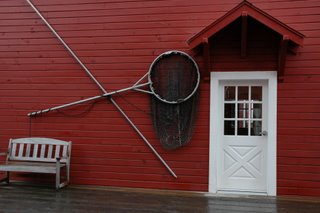
a couple of seaside restaurants with different names but serving the same menu at Disney-esque prices, a shoreside to forest trail – again very tidy-looking, and a place to get a Disney-ish photo of our ship. 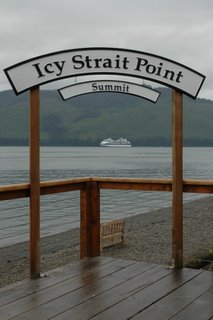
(Only one ship is allowed to visit each day, so they must feel pretty safe hanging just the one ship’s sign up there.)
So, if you’re going to Hoonah, my advice would be to skip the Disney experience altogether and go on a bear watching tour instead. Or just don’t get off the ship at all!
Back on ship, I dodged the formal evening in the dining room, enjoyed pasta from the pasta bar in my jeans and sneakers instead, read my books and watched for bald eagles and orcas on our way back out

After dinner, Kathie and I reunited on the top deck to walk our hearts out. As we came back into the open ocean, we saw a lighthouse on the point and a pancake glacier on the coastal mountains. The sky changed dramatically as we walked each of our fifteen laps, culminating in the treat of the day - a double rainbow that circled all the way around the back of the ship! It was so close it looked like we could have reached out and touched it - ok, well, maybe if we’d had thirty foot long arms. Too cool!
On what was the summer solstice in the lower 48 states, the golden sun set at 10:20 p.m. But the sky never did get dark.
Friday, August 11, 2006
Uh, Kath, Could We Just Sit-ka Down for a Minute? (or, Excuse Me, Ma’am, Is This Sit-ka Taken?)
Sitka on Baranof Island was settled in 1799 by Russians, who came to trap otters, seals, and blue foxes for their pelts. An active fur operation was maintained for almost 70 years by the government-supported Russian American Company. When wars left the Russian government in dire financial straits (and overtrapping left few otters to sell), Alaska was sold to the US for $7.2 million in 1867.
Today, Sitka has about 9,000 residents and, at least according to one source, the largest area of any of Alaska’s “cities”. If the calluses on my feet were any judge, I’d have to say that this last is a true fact:), and Kathie and I covered a fair amount of it. From the time we set foot on land to the time we re-boarded the tender boat five and a half hours later, Kathie and I did not sit down once…not even to each lunch!
We saw or visited:
The Sheldon Jackson Museum, which has the “best ethnographic collection in Alaska, and it's one of the finest small museums anywhere. Even the building is an artifact: Alaska's first concrete structure (1895), and a product of the Victorian Era's dubious flirtation with the octagon.” (Sorry, I've lost the reference for this!)
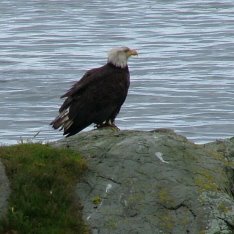
Bald eagles flying around like crows and lighting in tree tops to spread their wings to dry,
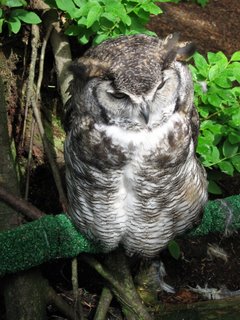
the Alaska Raptor Center, where we saw Arizona the owl and at least one rescued bald eagle told us, “I AM smiling”,
lots of beautiful flowers in people’s yards,
the Russian cemetery, all overgrown by rainforest and hauntingly beautiful, and
Castle Hill - no castles standing anymore but still the site is pretty cool. And very historic: this is where the sale of Alaska to the US was finalized.
Back on ship, we finally got to eat. We read our camera books, napped, and I did sudoku puzzles. That night, we dined in the dining room, where I carried on a conversation with Bob about health care and, again, ate too much.
Bedtime at 9:30 pm was most welcome.
(Check out some really cool photos on this Sitka website's photo contest.)

